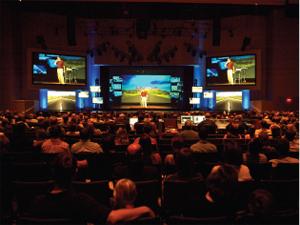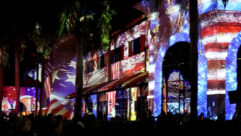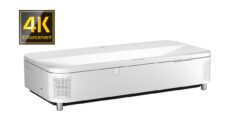

Seeing the (Bright) Light
It could be argued that everyone who slings a projector is trying to present an inspirational message, but few can make that claim like the increasing number of large, modern houses of worship increasingly adopting bright, large-scale projection technology.
Among other projectors it installed,Clark ProMedia went with the BarcoXLM HD30 for maximum brightness.
Credit: Brian Korosec
CHALLENGE:
Ensure uniform brightness and a lifelike HD picture projected across various screen sizes in several disparate church venues.
SOLUTION:
Understand all lighting conditions and employ highbrightness DLP projectors while adhering to custom standards that fit the client’s situation.
It could be argued that everyone who slings a projector is trying to present an inspirational message, but few can make that claim like the increasing number of large, modern houses of worship increasingly adopting bright, large-scale projection technology. The Atlanta area’s North Point Community Church is a good example.
“Our venues range from 100 seats for elementary-age children all the way through 3,000 seats plus,” says Bob Nahrstadt, director of engineering at Clark ProMedia, an Alpharetta, Ga., performance-engineering fi rm that has worked for North Point since the church’s founding in 1996.
Clark ProMedia has outfi tted four large auditoriums for adult members and several smaller auditoriums for youth and children on four Atlanta-area campuses, with services in the main Alpharetta campus simulcast to the satellites. In the past year, it helped North Point implement a “virtual teaching” program. “The teacher doesn’t have to be present on the stage,” Nahrstadt says.
Projection technology has been key to all the church’s initiatives. But integrating it properly required attention to detail.
BRIGHTEST STARS
Church leaders set out to deliver their message with a high degree of impact. “We wanted [church founder] Andy Stanley to look lifelike on the screen,” Nahrstadt says.
Image magnifi cation techniques create the video realism, according to Peter Taylor, director of sales at Barco, the main supplier of the high-brightness projectors used at North Point. “It uses a video camera to show a close-up image of those singing or speaking,” Taylor says. “Couple this with high-resolution projection, appropriate lighting, and a good screen, and the projected images appear photo realistic.”
The adult venues all have 3-chip DLP projectors. A 17-feet-high, 28-feetwide Stewart Filmscreen receives rearprojected light from a 30,000 centerlumens Barco XLM HD30 powered by a 6.3-kilowatt, high-pressure xenon lamp. The projector has a rated contrast ratio of 1,600:1 and native HD resolution of 2,048 x 1,080.
A close-up, magnifi ed image of the same scene appears on two smaller Stewart screens, shot from two 12,000 ANSI lumen (13,500 center-lumen) Barco SLM R12+ projectors with a 2.2-kilowatt xenon bulbs, 1,400 x 1,050-pixel SXGA+ resolution that can be “pixel-blanked” to produce a wide, 16:9 aspect ratio, and 2,000:1 contrast.
“The XLM HD30 is what really gives us the ability to have the level of brightness on the big screen that matches the brightness on the two side screens,” Nahrstadt says. Front projection is used on all the side screens and on center screens in some venues.
The installation isn’t all DLP, however, with LCD projectors “for smaller screens, smaller rooms, and lower budgets,” Nahrstadt says. Some have 6,600-lumen Christie LX-66A models, though others have DLP-based, 3,000-lumens Casio XJ-560 projectors. LCD lost out to DLP in the large venues because the brightness and quality requirements of the screen sizes demanded it, he says.
The screens were carefully chosen, but not necessarily to optimize brightness. “We like to use low-gain screens because we think they provide better offaxis viewing,” Nahrstadt says. “We don’t rely on screen gain to try to increase brightness. We think that’s too much of a compromise on viewing angle.”
The North Point screens have gains of less than 1.0, which means they essentially refl ect no light back to the viewer. “If we need more brightness, we use a brighter projector,” he says.
SEEING IS BELIEVING
Rather than trying to convince the client with spec sheets and light meter readings, Clark ProMedia showed church officials projectors in action. That’s not to say Clark ProMedia ignored science. It developed its own standard for recommended brightness, along with proprietary methodologies and calculations for reaching that brightness in foot-lamberts, according to Nahrstadt. When choosing projectors, “we can simply identify the amount of ANSI lumens that are going to be required to provide that foot-lamberts per square feet,” he says.
While some vendors only quote center lumens on certain projectors, Nahrstadt says he prefers ANSI lumens because he trusts its methodology. “We know that testing methodology takes more of the uniformity of the screen into account,” he says. Clark ProMedia refers to vendors’ contrast-ratio claims but then tries to measure them against its experience, and employs tools from the Imaging Science Foundation to calibrate projectors.
Nahrstadt stresses the importance of picking projectors with full awareness of the wide variations in light conditions. Clark ProMedia’s task was simplifi ed by a relative lack of ambient light– Nahrstadt says all the spaces are essentially performance venues with theatrical lighting that is completely managed from control panels. Still, projector brightness had to fit within, not dictate, the other lighting decisions. North Point, for example, uses bright light when worshippers fi le out fi le in and out. “You don’t want the projector to get in the way of the lighting director lighting his room the way he wants,” he says.
Taylor says lighting plays a signifi – cant role in realism. “With IMAG, a slight shadow across the pastor’s face that is normally not noticeable could look like a dark blotch to someone watching the large screen,” he writes. “House lighting needs to be balanced. The worshippers should be able to take notes, but they should also be able to see the screens clearly.”
Taylor also recommends shooting a gray-scale pattern containing full black and white content onto the screen to adjust projector contrast. “Make sure the black level is as dark as possible without crushing the black details, then do the same for white,” he says.
As for emerging technologies, Clark ProMedia is taking a look at LED offerings for another client. “The reason we’re looking at LED is for brightness,” Nahrstadt says. “The image would need to be seen both indoors and outdoors.” He says the LED option shows much promise and is the only way to show quality full-motion video outdoors.
Nahrstadt’s parting advice on projector brightness? “You can always turn it down, but you can’t always turn it up. So when in doubt, go bright.”










